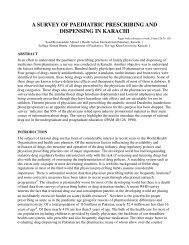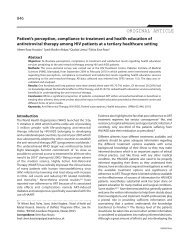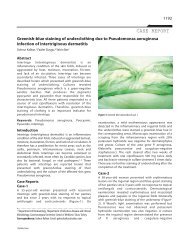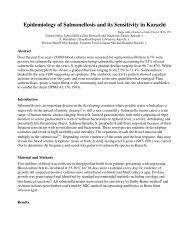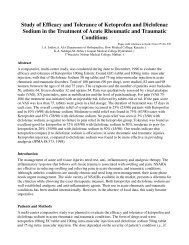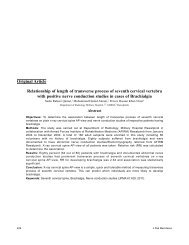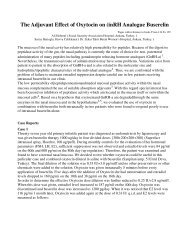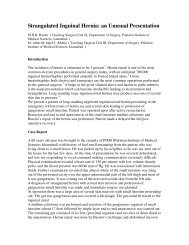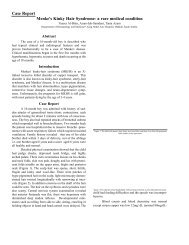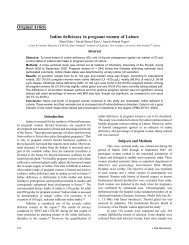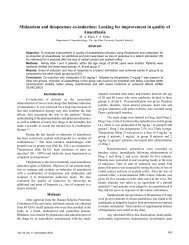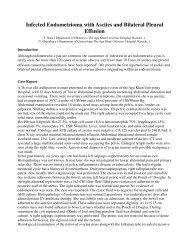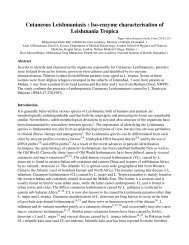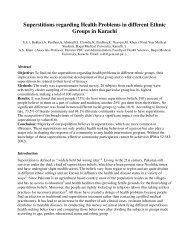Effect of Single Dose of Secnidazole in Treatment of Intestinal ...
Effect of Single Dose of Secnidazole in Treatment of Intestinal ...
Effect of Single Dose of Secnidazole in Treatment of Intestinal ...
Create successful ePaper yourself
Turn your PDF publications into a flip-book with our unique Google optimized e-Paper software.
<strong>Effect</strong> <strong>of</strong> <strong>S<strong>in</strong>gle</strong> <strong>Dose</strong> <strong>of</strong> <strong>Secnidazole</strong> <strong>in</strong> <strong>Treatment</strong> <strong>of</strong> Intest<strong>in</strong>al<br />
Amoebiasis<br />
Introduction<br />
Pages with reference to book, From 159 To 159<br />
Gh. Omrani, M. Khamseh ( Shiraz University <strong>of</strong> Medical Sciences, Tehran, Iran. )<br />
A. Rastegar-Lari ( University <strong>of</strong> Medical Sciences, Tehran, Iran. )<br />
Nitroimidazoles are highly potent antiprotozoal agents with well- established <strong>in</strong>dications. S<strong>in</strong>ce the<br />
discovery <strong>of</strong> metronidazole, a member <strong>of</strong> this group, the treatment <strong>of</strong> amoebiasis has been<br />
revolutionized 1,2 . Despite its extreme potency aga<strong>in</strong>st E-histolytica, metronidazole has to be taken for a<br />
relatively long penod (10 days) and hasvanous side effects <strong>in</strong>clud<strong>in</strong>g headache, metallic taste, nausea,<br />
diarrhoea and abdom<strong>in</strong>al discomfort. <strong>Treatment</strong> failure are relatively common due to poor patient<br />
compliance 3 . Another mtroimidazole, namely (hydroxy-2-propyl) 1-methyl-2- nitro-5-imiolazole,<br />
(<strong>Secnidazole</strong>), with a molecular weight <strong>of</strong> 184.18, is the first <strong>of</strong> group which <strong>of</strong>fers a 3-day<br />
antiprotozoal effect from a s<strong>in</strong>gle dose. This pharmacok<strong>in</strong>etic characteristic expla<strong>in</strong>s the good activity<br />
<strong>of</strong> secnidazole aga<strong>in</strong>st <strong>in</strong>test<strong>in</strong>al amoebiasis. We tried secnidazole <strong>in</strong> the treatment <strong>of</strong> <strong>in</strong>test<strong>in</strong>al<br />
amoebiasis <strong>in</strong> Shahid Faghihi Hospital <strong>of</strong> Shiraz.<br />
Patients, Methods and Results<br />
Twenty-two patients (mean age 32 years) with dysentery, tenesmus and bloody stool which were<br />
positive for trophozoite <strong>of</strong> E. histolytica, were entered <strong>in</strong> the study. Seven asymptomatic earners (mean<br />
age 38 years) were also <strong>in</strong>cluded. Results <strong>of</strong> physical exam<strong>in</strong>ation and pre-treatment symptoms such as<br />
abdom<strong>in</strong>al pa<strong>in</strong>, loose stool and hematochezia were recorded <strong>in</strong> detail. Stool specimens obta<strong>in</strong>ed were<br />
exam<strong>in</strong>ed microscopically and cultured to conf<strong>in</strong>n the diagnosis <strong>of</strong> acute and chronic amoebiasis. All<br />
patients were given 2 gra<strong>in</strong>s (4 tablets <strong>of</strong> 500 mg) <strong>of</strong> secnidazole <strong>in</strong> a s<strong>in</strong>gle oral dose. They were<br />
<strong>in</strong>structed to record details <strong>of</strong> all compla<strong>in</strong>ts and side effects and were asked to return for reexam<strong>in</strong>ation<br />
and stool culture, three weeks after treatment. Responses to treatment were classified as<br />
“cl<strong>in</strong>ical cure” when all signs and symptoms disappeared and “parasitological cure” when stool<br />
cultures for amoeba were negative. Culture media were prepared with some modifications. Two<br />
cultures were used for each specimen. 30 mg <strong>of</strong> rice powder was added to both streptomyc<strong>in</strong>e and<br />
penicill<strong>in</strong>s were added to just one <strong>of</strong> the media. Stool specimen was added to both media and <strong>in</strong>cubated<br />
at 37°C for 24 hours.<br />
Thirty-two patients (25 with acute and 7 with chronic amoebiasis) from Shahid Faghihi Hospital <strong>in</strong><br />
Shiraz entered the study. Bloody stool (100%), abdom<strong>in</strong>al pa<strong>in</strong> (50%), tenesmus (45%) and bowel<br />
movement upto six times per day were the major compla<strong>in</strong>ts. Chronic carriers with cyst <strong>of</strong> E.<br />
histolytica <strong>in</strong> stool had no sign and symptom. After adm<strong>in</strong>istration <strong>of</strong> secnidazole, there was significant<br />
improvement <strong>of</strong> symptoms. In all acute cases, the frequency <strong>of</strong> bowel movements decreased to once a<br />
day. Bloody stool and abdom<strong>in</strong>al pa<strong>in</strong> disappeared with<strong>in</strong> 24-48 hours. On parasitological exam<strong>in</strong>ation<br />
only 1 (16%) out <strong>of</strong> 7 patients with chronic amebiasis had positive stool culture three weeks after<br />
treatment while all other were negative. None <strong>of</strong> the side effects which are common with<br />
nitroimidazole derivatives like nausea, vomit<strong>in</strong>g, vertigo, ataxia and metallic taste, were observed <strong>in</strong><br />
our patients.<br />
Comments
<strong>Secnidazole</strong>, the newest among the mtroimidazole group, has a much longerhaif life compared to<br />
metronidazole, t<strong>in</strong>idazole and ormidazole 4 . The results <strong>of</strong> present study confirm the previous reports on<br />
effectiveness <strong>of</strong> s<strong>in</strong>gle dose <strong>of</strong> secnidazole <strong>in</strong> reliev<strong>in</strong>g cl<strong>in</strong>ical symptoms with high parasitological cure<br />
rate <strong>in</strong> patients with acute and chronic amoebiasis 5-9 . However, compared to widely used drugs such as<br />
metromdazole with long duration <strong>of</strong> treatment and the side effects, which have significant<br />
disadvantages to their use 10 , secnidazole appears to be superior due to the s<strong>in</strong>gle dose <strong>of</strong> the drug and<br />
better compliance and lack <strong>of</strong> untoward side effects.<br />
Acknowledgements<br />
Help <strong>of</strong> Pr<strong>of</strong>essor M. Mahmoudian and Dr. M. Motevalian <strong>in</strong> preparation <strong>of</strong> this manuscript I gratefully<br />
acknowledged.<br />
References<br />
1. Rossigno!, J. F and Maionneuve, H. Nitroimidazoles <strong>in</strong> the treatment <strong>of</strong> trichomoniasis, giardiasis<br />
and amebiasis Int. J. Cl<strong>in</strong>. Phannacol. Ther. Toxicol., 1984;22:63-72.<br />
2. Rosenblatt, J. E. and Eson, R. S. Metronidazole, Mayo Cl<strong>in</strong>. Proc., 1987;62:1013-1015.<br />
3. Roe, F. J. C. Metronidazole: Review <strong>of</strong> uses and toxicity. J. Antimicrob. Chemother., 1 977;3:205-<br />
207.<br />
4. Bassily, S., Farid, Z.,Masry, N. A. eta!. <strong>Treatment</strong><strong>of</strong><strong>in</strong>test<strong>in</strong>alE. histolyticand G. lambia with<br />
metronidazole, t<strong>in</strong>idazole and omidazole: A comparative study. 3. Trop. Med. Hyg., 1987;90:9-12.<br />
5. Andre, L. J. Cl<strong>in</strong>ical studies <strong>of</strong>secnidazole <strong>in</strong> acute <strong>in</strong>test<strong>in</strong>al amebiasis. Am. J. Gast. Hepat.<br />
1979;15:221-225.<br />
6. Soed<strong>in</strong>, K., Yukran, 0. K., Fadillah, A. eta!. Comparison between the efficacy <strong>of</strong> a<br />
s<strong>in</strong>gledose<strong>of</strong>secnidazolewith a 5-days course <strong>of</strong> tetracycl<strong>in</strong>e and clioqu<strong>in</strong>ol <strong>in</strong> the treatment <strong>of</strong> acute<br />
<strong>in</strong>test<strong>in</strong>al amoebiasis. Pharmatherapeutica, 1985;4:251-54.<br />
7. S<strong>in</strong>uhji, A. B., Lubis, C. P.. Daulay, H. R. et al. A double bl<strong>in</strong>d trial between metronidazole and<br />
secnidazole <strong>in</strong> acute amebic dysentery <strong>in</strong> children. (prelim<strong>in</strong>ary report) amebiasis Paediatr. Indones.,<br />
1986;26:9-12.<br />
8. Cesari, M., Condat, M., Gendron, Y. et al. Traitement de 1, amibiase par le secnidazole en cure<br />
courte.Med. Trop., 1982;52:527-529.<br />
9. Lat<strong>in</strong>o, A. Efficacy <strong>of</strong> a s<strong>in</strong>gle-dose secnidazole <strong>in</strong> the treatment <strong>of</strong> acute and chronic amebiasis. J.<br />
Trop. Med. Hyg., 1988;91:202-204.<br />
10. Oren, B., Schgurcnsky, E. Epros, M. et a!. <strong>S<strong>in</strong>gle</strong>-dose ornidazole verses seven-Dog Metronidazole<br />
therapy <strong>of</strong>giardiasis <strong>in</strong> Kibbutizm children. Europ. J. Cl<strong>in</strong>. Microbiol. Infect. Dis. 1991 ;10:963- 965.



